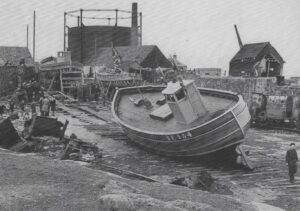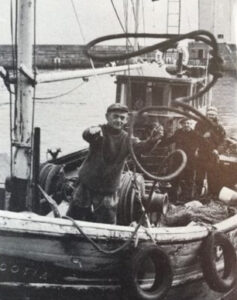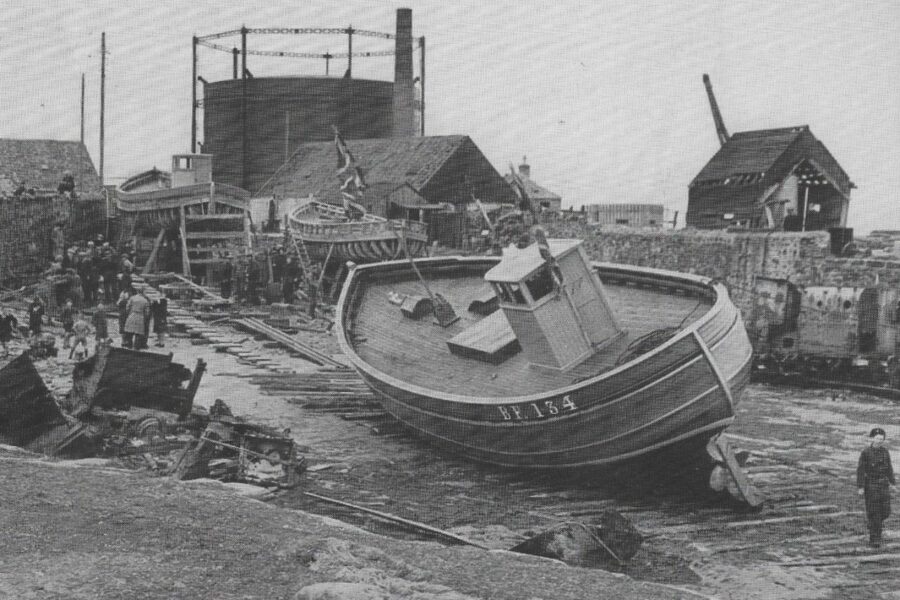Now working from Whitehaven, this 1956 John Watt & Sons build is still going strong
John Watt & Sons started work in 1940 on a Gardenstown site called New Ground, which presumably was reclaimed land. The yard built a range of clinker lifeboats and motor boats until moving into carvel-built vessels such as the 52ft Seafield BF 143 in 1946 and the 58ft Snowflake BF 309 in 1948 – the last boat that was built at that site.

The Stephen’s yard in 1946, shortly before John Watt took it over.
Where the yard was has now been built over. There’s a story about a winch that was used to haul boats up the 1880s slipway, and which was still hauling the salmon cobles up in the 1960s – there was a salmon bothy nearby for the bag-nets offshore. When the winch was in use it was attached to a few links of a chain that was otherwise buried and attached to a large anchor.
In the 1970s, when council workers were tarmacing the road, they attempted to pull the anchor out with a digger until a man known as ‘Wallie’s Willie’, who stayed at No 2 New Ground, came out laughing to say that the anchor was firmly under his house and that they’d be pulling his house down if they pulled too hard! Consequently they simply buried the chain and built the road over it.
In 1954, John Watt took over and moved into the Stephen’s yard at the harbour in Banff where there was a patent slip, allowing them to build larger vessels. The fifth fishing boat they launched from that site in 1956 was the 39.5ft Scotia BCK 37, built for a consortium of four partners: brothers William and Andrew Wood of Portknockie, John James Gardiner of Findochty and Davie Sutherland. At just under 40ft, like many of the early John Watt boats, she could fish inside the three-mile limit. She survives, working today from Hartlepool.

The Watt workforce: Willie and George Watt, Billy Watt, Stephen West, James Ritchie Watt, George West, Andrew Reid, John West, Francis Lamb and John Watt. (Photo: Eleanor Hepburn)
The consortium crewed the boat together and spent most of their time fishing for prawns in the Minch. They’d land the prawns into Gairloch along with two other vessels, one of which was the John Watt-built Moray Gem BCK 28 (decommissioned in 2002).
Their prawns would go on to Aberdeen, whilst any whitefish would be sold daily in Stornoway. Every two weekends they’d hire a bus to transport all the crew of the three boats – sometimes four when the crew of the Green Pastures joined them.
They had an anchorage at Shieldaig where they’d sometimes stop at a weekend when there was no Sunday fishing. But they’d also base themselves in other parts of the coast. In 1959 they were at the Loch Fyne herring and, it being a Sunday, moored up at Tarbert. They wrote letters home and walked up to the post office to post them, and then on to West Loch Tarbert and back, when tragedy struck.
John Gardiner’s grandson Steven told me the story: “Davie Sutherland and my grandad were yarning as they walked. A van came along and knocked my grandad into the ditch. Davie was picked up and carried along on the bonnet of the van. A woman later found Davie’s body further along the road. He was only 47 years old.
“They did trace the driver, and he was prosecuted.”

Scotia soon after her launch.
John Gardiner got away with some cuts and a sore head. The three remaining shareholders bought out Davie Sutherland’s share in the boat and paid it to his widow.
I asked Steven what he remembered about his grandfather. “It’s hard to remember much as I was only born in the 1960s, but I do recall his hands. They were like leather from all the work. It was hard work, tough – no winches, and having to move coils around the deck by hand, hauling nets. All they had was a coiler.
“But the boat is still going, so she must have been made of good stuff. She was a bit fuller than the Moray Gem – not as fast, but lasted longer.”
Steven thinks the Scotia was sold a year before his grandfather retired, as he spent a year working on another boat beforehand. Colin Moore from Workington bought her next, and I’m told didn’t work her hard, as he had another job and often only used her at weekends. However, I believe he did a fair amount of work to her hull, replacing some planking, especially around the bulwarks.

Scotia amongst the fleet.
About 2003 he sold her to Kevin Jenkinson, her present owner. Although for the first 15 years Kevin worked her quite hard, mostly prawning, and often working from Hartlepool and North Shields, she remains based in Whitehaven.
These days he still works the prawns, but he does also go to the skate in winter. Over the last five years he’s relaxed a bit and tends to work 12-hour trips, selling off the quayside on his return rather than taking his chances on the market. In 2012 he re-registered her as WA 37.
I asked about upkeep. “I’ve replaced the shaft, new propeller, new wheelhouse, electrics, hydraulics, and I’ll probably refurbish the engine this year. It’s the same Gardner 6LX, but it’s been de-rated to 78hp. You can give the crankshaft so much oil, but the pistons and liners wear regardless. It suits me fine, as it’s economical and she still speeds along at 7.5 knots. And she’s a quiet boat – not like these things with 300hp below decks!”

Skipper John Gardiner throwing a line ashore.
Kevin has two boats at present, running the steel Kinloch SY 350 alongside Scotia, but he reckons he will sell the Kinloch and keep Scotia as she’s perfect for him.
“I’m 57 now and want to retire soon. I’ll be able to operate her single-handed, with controls to hand. That will suit me, pottering around. She’s in good condition, well built. There’s a knee every rib. She’s so solid, and she’s quite deep with a 7ft draught; she weighs 8t.
“She’s very stable, and I’ve never felt unsafe in her. But I think she’s never worked that hard over the last 40 years which has contributed to her longevity. She has that old-fashioned look, and I reckon she’ll probably outlive me!”
The Scotia is one of the oldest in the British fleet, and has had three owners, no name change, and one PLN change. For that she must almost be unique.
Thanks to Douglas Paterson, Eleanor Hepburn, John O’Neill, Steven Gardiner and Kevin Jenkinson.
This story was taken from the archives of Fishing News. For more up-to-date and in-depth reports on the UK and Irish commercial fishing sector, subscribe to Fishing News here or buy the latest single issue for just £3.50 here.
Sign up to Fishing News’ FREE e-newsletter here.








